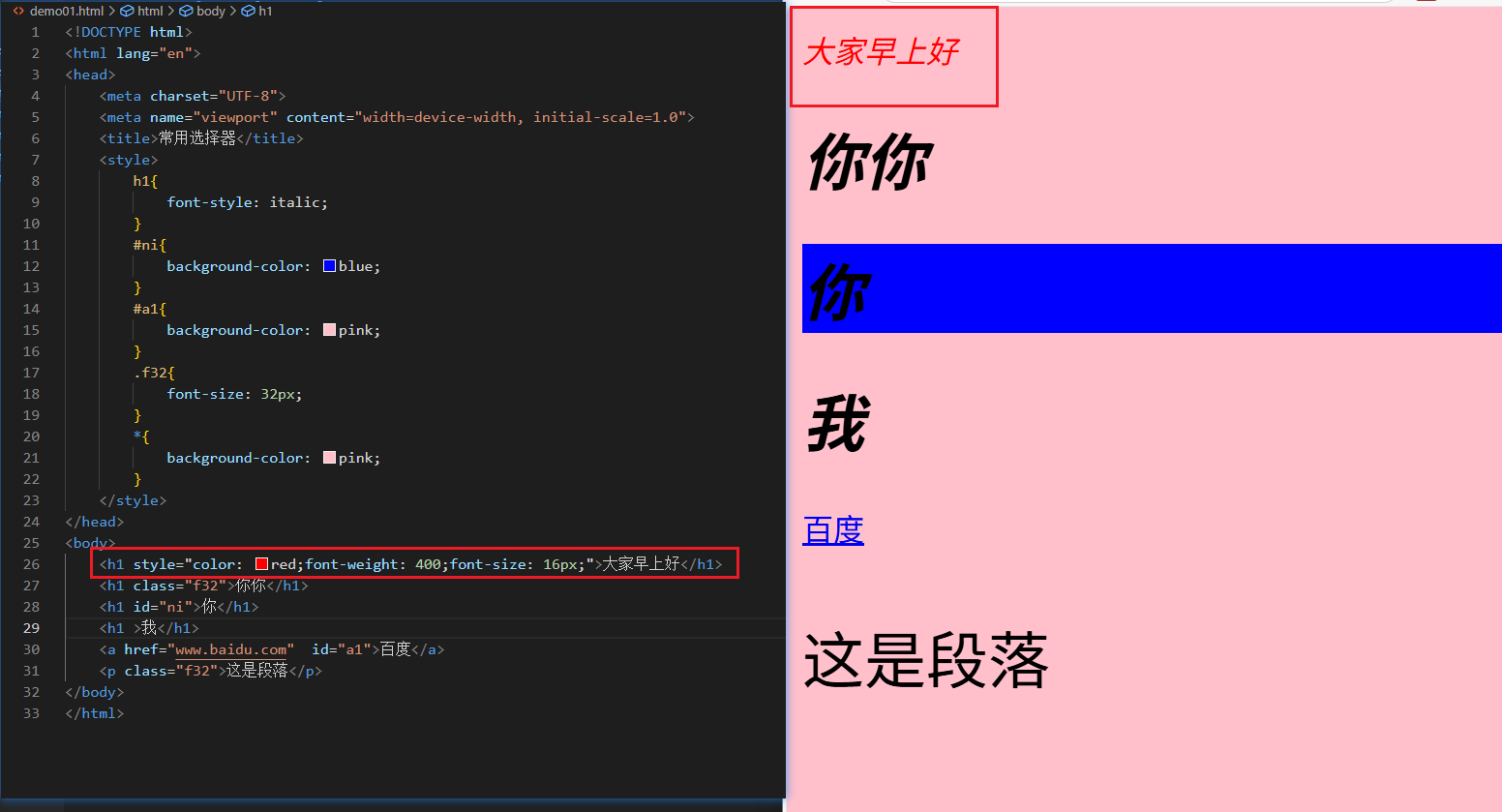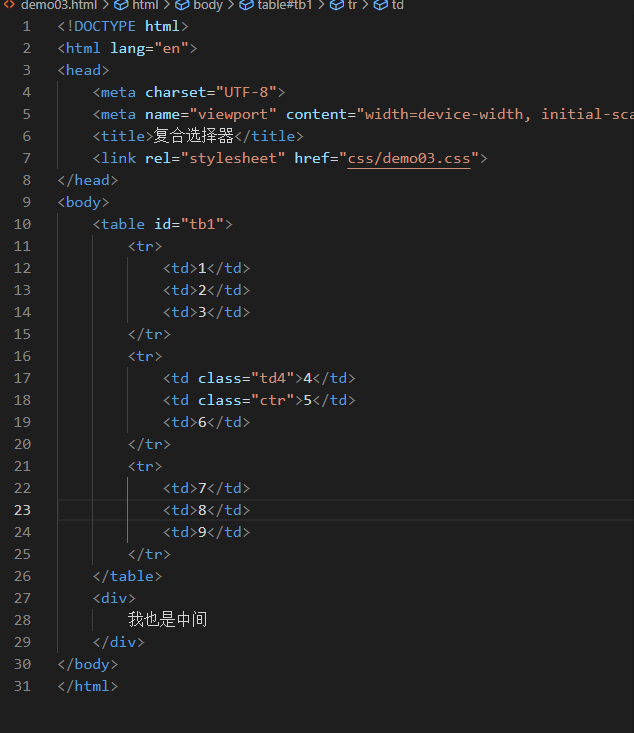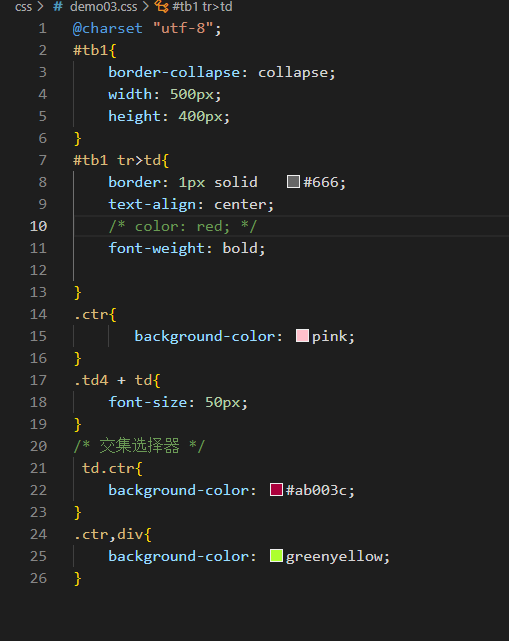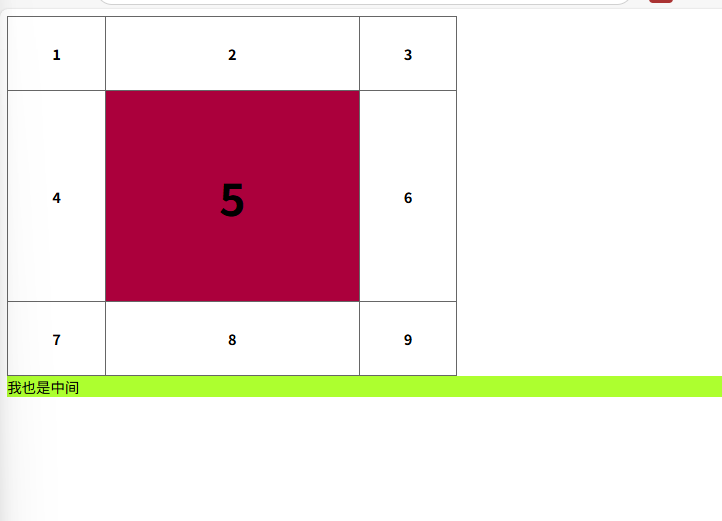文章目录
CSS复习
前端三大件:无竞品,极简
html:框架结构
css:负责样式修饰
js:行为交互,动画效果
CSS:层叠样式表 Cascade Style Sheet
1. css三种引入方式
1.1 行内样式
写在标记之中,使用style属性
样式之间无顺序
常用样式:
color:前景色 颜色:
1.1英文单词
1.2RGB表示法
1.3.RGB表示法的16进制写法。#ab00c3
1.4.简写的十六进制表示法 如果每两位相同则可简写为一位#000font - weight:字重
font-size: 30px 字号
weight宽 400px
height高 400px
font-family 字体 如"宋体"
text-decoration,文字周围各种线,比如underline下划线
text-align: ;文本位置,如center居中
缺点:仅能修饰行内标记
px:像素 是逻辑像素 不同电脑1px不一定一样大
物理像素:真实发光点一共多少个
逻辑像素:类似缩放,把几个物理像素合成一个
1.2页内样式
选择器。用来选择修饰的目标元素
缺点:仅能修饰当前页
常见选择器:
1. 标记选择器
h1{
}
就是选择页面中所有h1标记
2. id选择器
<h1 id="ni">你</h1> 赋予一个id,
在style里:
#ni{
background-color: blue;
}
得到id为ni的标记被设置背景色为蓝色
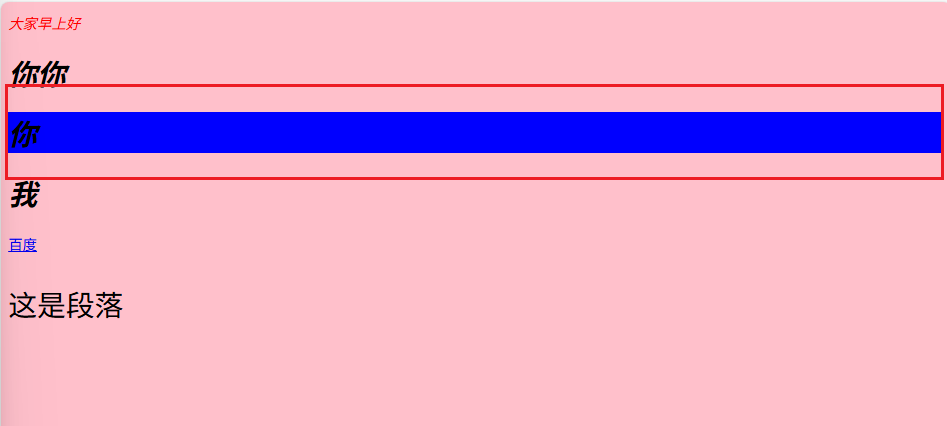
3. 类选择器(最常用)
<h1 class="f32">你你</h1>
<p class="f32">这是段落</p>
class表示同一类
在style里写
.f32{
font-size: 32px;
}
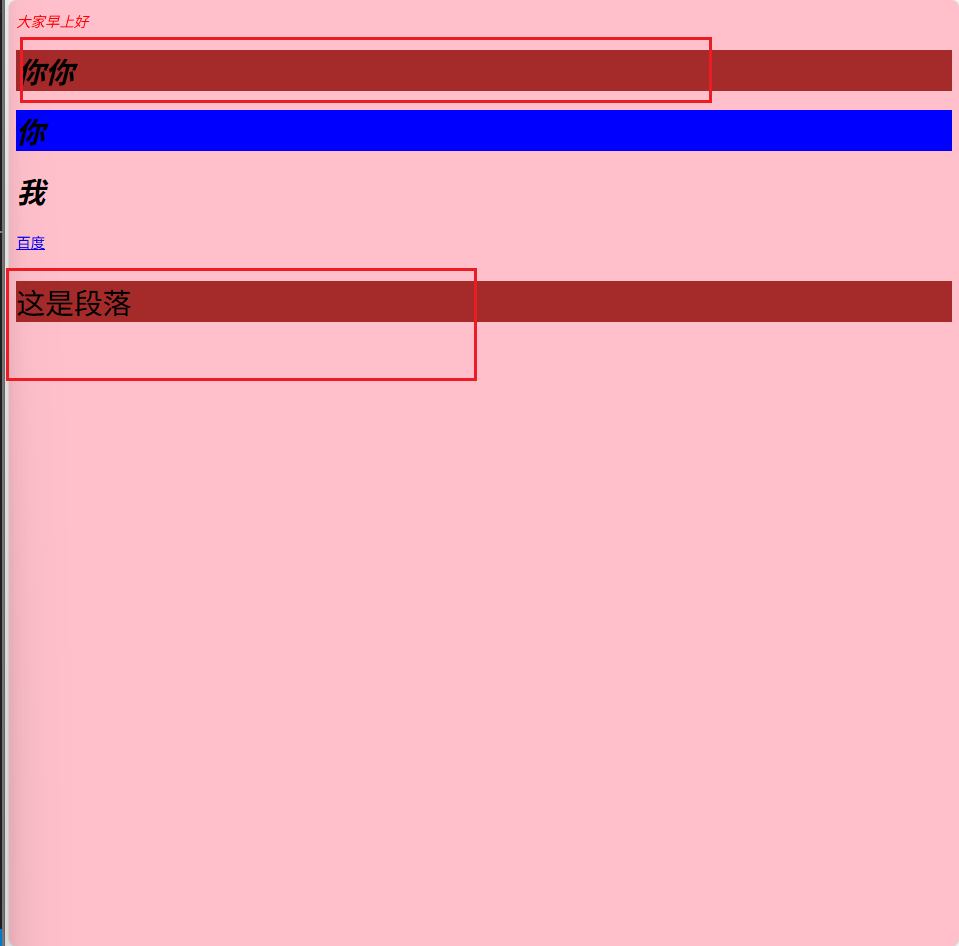
4. 星号选择器,频率很低
全局选中:
*{
background-color: pink;
}
5. 复合选择器
高级选择器,将基础选择器组合使用
- 子代选择器 a>b 只能选择直接子代,比如h1嵌套p,p嵌套a,则h1和p是子代关系,h1不能选择a
2. 后代选择器 a b,依照上例,h1可以嵌套a
3. 兄弟选择器 a+b紧邻弟或者 a~b 所有弟,注意:该选择器修改的不包括a自己
4. 交集选择器 ab 注意书写不要让浏览器产生歧义,修改的是b的属性
5. 并集选择器 a,b,修改的是a和b的属性
6. 伪类选择器:
1. 超链接伪类 爱恨准则 :hover对一切标记有效 其他三个只对超链接有效: :link 超链接默认状态下 :visited 访问过后 :active 激活态
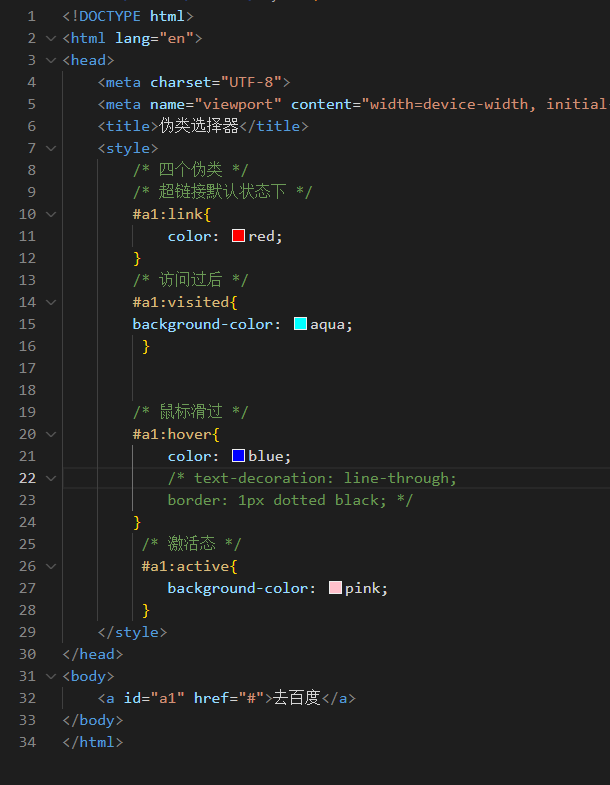
7. 子元素伪类
:first-child :last-child nth-child(3) /* 第一个儿子前加一个元素 */
ul::before{
content: "A";
}
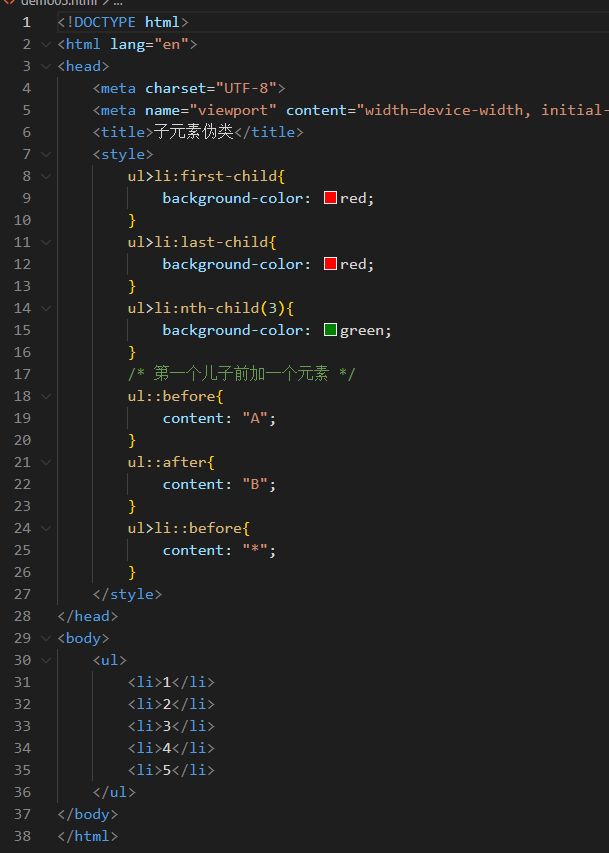
- 伪元素选择器
1.3引入外部样式表文件
目前企业开发最常用
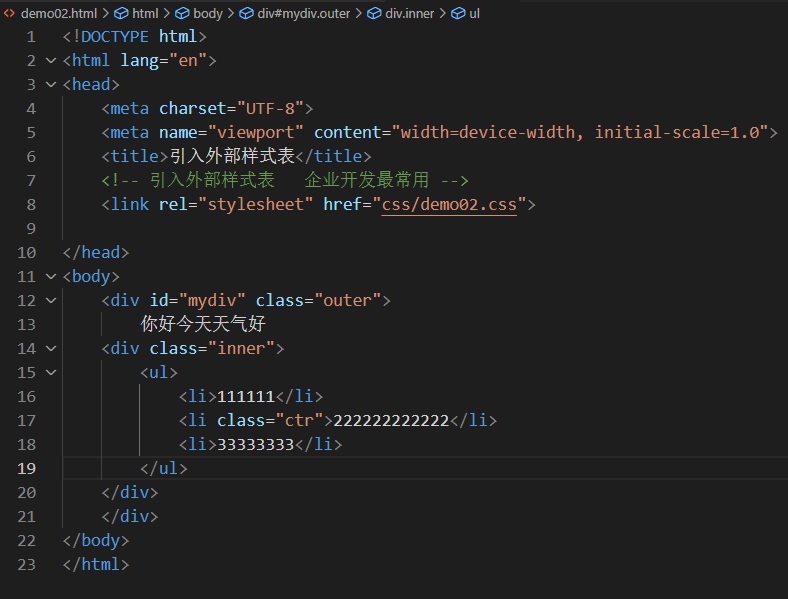
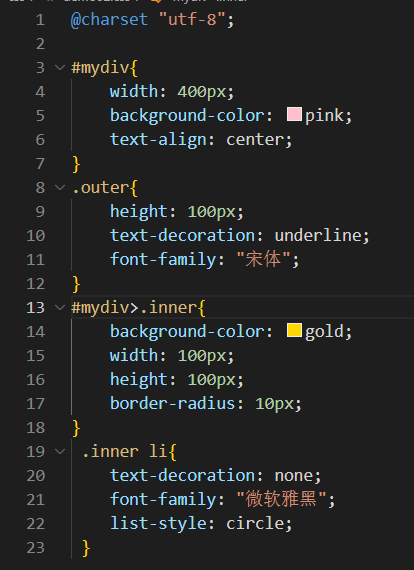
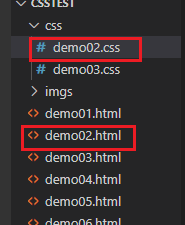
盒模型 Box-Model
在css中,将任意一个元素,都视作一个盒子。
margin 外边距
padding 内边距
border 边框
<!DOCTYPE html>
<html lang="en">
<head>
<meta charset="UTF-8">
<meta name="viewport" content="width=device-width, initial-scale=1.0">
<title>盒模型</title>
<style>
.outer{
width: 400px;
height: 200px;
background-color: pink;
border: 10px solid green;
/* 外边距 */
/* margin: 30px; */
/* 四个单独写,外边距上下左右 */
margin-left: 30px;
margin-right: 30px;
margin-top: 30px;
margin-bottom: 30px;
/*写四个 顺时针方向 上右下左 */
/* margin: 10px 20px 30px 40px; */
/* 写三个 :上 左 右 */
/* margin: 10px 20px 30px; */
/* 写两个 上下 左右 */
/* 内边距 */
padding: 20px;
/* padding-left: 10px;
padding-right: 20px;
padding-top: 30px;
padding-bottom: 40px; */
/* 左边框 */
/* border-left: 10px solid green;
/* 右边框 */
/* border-right: 20px dotted green; */
/* 边框 */
border: 30px solid green;
border-width: 30px 30px 30px 30px;
border-style: solid solid solid solid;
border-color: green;
}
</style>
</head>
<body>
<div class="outer">1111</div>
</body>
</html>
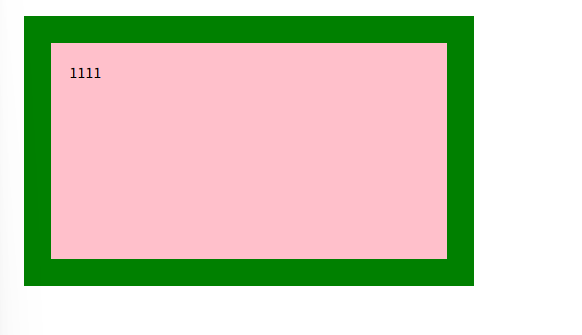
如何给块元素添加背景图片
background-image: url(./imgs/image.png);
<!DOCTYPE html>
<html lang="en">
<head>
<meta charset="UTF-8">
<meta name="viewport" content="width=device-width, initial-scale=1.0">
<title>背景图片</title>
<style>
.outer{
width: 800px;
height: 800px;
background-color: pink;
background-image: url(./imgs/image.png);
/* 平铺模式 */
/* 不平铺 */
background-repeat:no-repeat ;
/* 横向平铺 */
/* background-repeat: repeat-x; */
/* 纵向平铺 */
/* background-repeat: repeat-y; */
/* 大小 宽 高 */
/* 背景图的尺寸 */
/* background-size: 30px 30px; */
/* background-size: auto 50px; */
/* 缩放到背景图片正好能被包含,确保整个背景图片都显示在元素背景中,图片不会被裁剪,但这可能导致元素中留有空白区域。 */
/* background-size: contain; */
/* 缩放到正好覆盖整个元素背景 */
/* background-size: cover; */
/* 控制位置 */
/* background-position: 100px 100px; */
/* background-position: center; */
/* background-position: 10% center; */
/* 或者 */
/* background: pink url(./imgs/image.png) no-repeat center center / cover; */
}
</style>
</head>
<body>
<div class="outer"></div>
</body>
</html>
浮动
文档流的默认规则
1。块元素从下向上排列,独占一行
2,行内元素从左右排列
打破默认规则:
1.浮动:float
<!DOCTYPE html>
<html lang="en">
<head>
<meta charset="UTF-8">
<meta name="viewport" content="width=device-width, initial-scale=1.0">
<title>浮动</title>
<style>
.d1{
width: 200px;
height: 100px;
background-color: pink;
float: left;
}
.d2{
width: 300px;
height: 150px;
background-color: green;
float: left;
}
.d3{
width: 400px;
height: 200px;
background-color: yellow;
float: left;
}
/* 浮动顺序和.d1,.d2声明顺序无关,和下面定义顺序有关 */
.d4{
width: 40px;
height: 30px;
background-color: blueviolet;
}
.clear{
clear: both;
}
</style>
</head>
<body>
<div class="d1"></div>
<div class="d2"></div>
<div class="d3"></div>
<div class="clear"></div>
<div class="d4"></div>
</body>
</html>
例子:
横向菜单:
<!DOCTYPE html>
<html lang="en">
<head>
<meta charset="UTF-8">
<meta name="viewport" content="width=device-width, initial-scale=1.0">
<title>横向菜单</title>
<style>
.nav{
list-style-type: none;
margin: 0;
padding: 0;
}
.nav>li{
float: left;
background-color: rgba(0, 0, 0, 0.5);
padding: 8PX 5px;
}
.nav>li:hover{
background-color:chocolate;
}
.nav>li>a{
/* 下划线 */
text-decoration: none;
/* text-decoration: dashed; */
color: #fff;
}
/* .clear{
clear: both;
} */
/* 利用伪元素清除浮动 */
.nav::after{
content: " ";
display: inline-block;
clear: both;
width: 0;
}
</style>
</head>
<body>
<ul class="nav">
<li><a href="#">首页</a></li>
<li><a href="#">设备列表</a></li>
<li><a href="#">产品列表</a></li>
<li><a href="#">公司介绍</a></li>
<li><a href="#">关于我们</a></li>
<!-- <div class="clear"></div> -->
</ul>
</body>
</html>
清除浮动:
1.必须使用块元素
2。必须在所有浮动元素的后面
3.必须和浮动元素是兄弟
display表示将元素显示成什么格式
定位:打破默认文档流的规则
position 定位:
1static:静态定位
2.absolute绝对定位
3.relative:相对定位
4.fixed:固定定位
定位的参照物:
1.绝对定位:最近的祖先元素中,非static定义的元素。如果没有,则以body为参照
2.相对定位:以其自身未偏移前的位置为参照物。
3.固定定位:以用户的视区为参照
<!DOCTYPE html>
<html lang="en">
<head>
<meta charset="UTF-8">
<meta name="viewport" content="width=device-width, initial-scale=1.0">
<title>Document</title>
<style>
.outer{
width: 140px;
height: 140px;
background-color: pink;
/* 绝对定位 */
position: absolute;
/* 只生效两个,当不指定width和height的时候四个都生效 */
/* top: 200px; */
/* left: 100px; */
/* right: 100px;
bottom: 100px; */
margin-top: 200px;
margin-left:100px ;
}
.inner{
width: 100px;
height: 100px;
background-color: gold;
position: fixed;
top: 20px;
left:300px;
}
</style>
</head>
<body>
<div class="outer">
<div class="inner"></div>
</div>
<p>段落</p>
<p>段落</p>
<p>段落</p>
<p>段落</p>
<p>段落</p>
<p>段落</p>
<p>段落</p>
<p>段落</p>
<p>段落</p>
<p>段落</p>
<p>段落</p>
<p>段落</p>
<p>段落</p>
<p>段落</p>
<p>段落</p>
<p>段落</p>
<p>段落</p>
<p>段落</p>
<p>段落</p>
<p>段落</p>
<p>段落</p>
<p>段落</p>
<p>段落</p>
<p>段落</p>
<p>段落</p>
<p>段落</p>
<p>段落</p>
<p>段落</p>
<p>段落</p>
<p>段落</p>
<p>段落</p>
<p>段落</p>
</body>
</html>
##################################################################
布局
一个html页面的设计编写过程,就是布局的过程。
圣杯布局
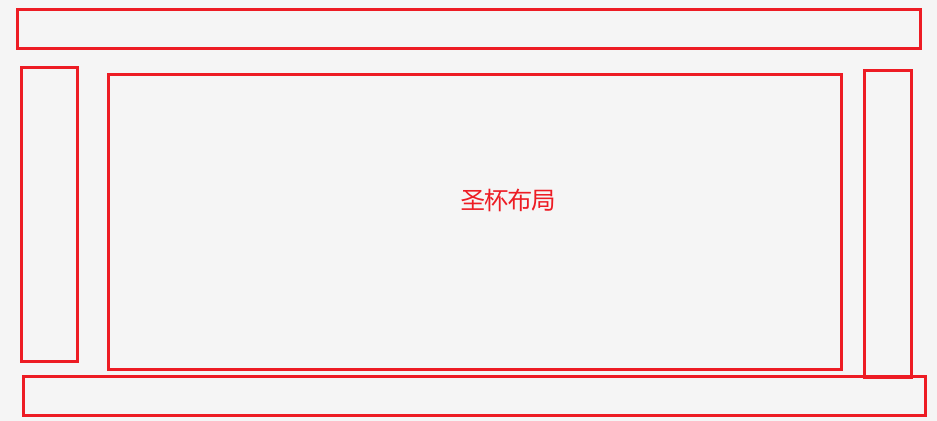
<!DOCTYPE html>
<html lang="en">
<head>
<meta charset="UTF-8">
<meta name="viewport" content="width=device-width, initial-scale=1.0">
<title>圣杯布局实现</title>
<style>
html,
body{
height: 100%;
/* background-color: pink; */
margin: 0;
}
.layout{
height: 100%;
}
.header{
height: 300px;
background-color: pink;
}
.center{
height: calc(100% - 400px);
background-color: aquamarine;
}
.footer{
height: 100px;
background-color: violet;
}
.center>div{
float: left;
}
.center::after{
content: " ";
display: block;
clear: both;
width: 0;
}
.center>.left{
width: 120px;
height: 100%;
background-color: aqua;
}
.center>.rgt{
width: 200px;
height: 100%;
background-color: gold;
}
.center>.main{
width: calc(100% - 320px);
height: 100%;
background-color: blueviolet;
}
</style>
</head>
<body>
<div class="layout">
<div class="header"></div>
<div class="center">
<div class="left"></div>
<div class="main"></div>
<div class="rgt"></div>
</div>
<div class="footer"></div>
</div>
</body>
</html>
等分布局

<!DOCTYPE html>
<html lang="en">
<head>
<meta charset="UTF-8">
<meta name="viewport" content="width=device-width, initial-scale=1.0">
<title>等分布局</title>
<style>
.outer{
width: 1500px;
height: 400px;
border: 1px solid #333;
margin: 0 auto;
}
.outer>.item{
float: left;
background-color: pink;
width: calc(20% - 8px);
height: 100%;
margin-right: 10px;
}
.outer>.item:last-child{
margin-right: 0;
}
.outer::after{
content: " ";
display: block;
clear: both;
width: 0;
}
</style>
</head>
<body>
<div class="outer">
<div class="item"></div>
<div class="item"></div>
<div class="item"></div>
<div class="item"></div>
<div class="item"></div>
</div>
</body>
</html>
